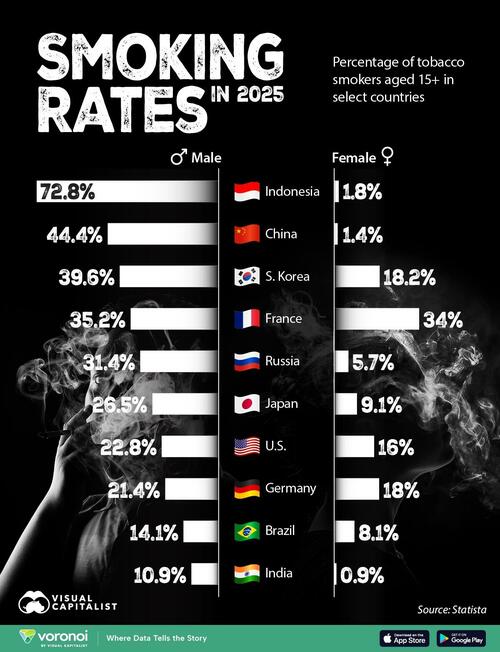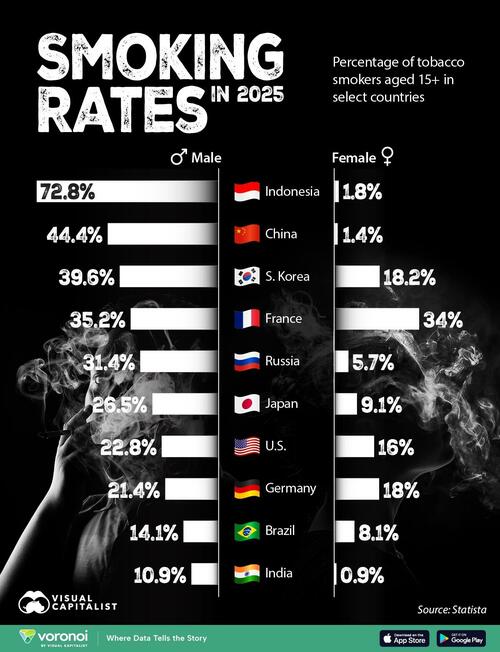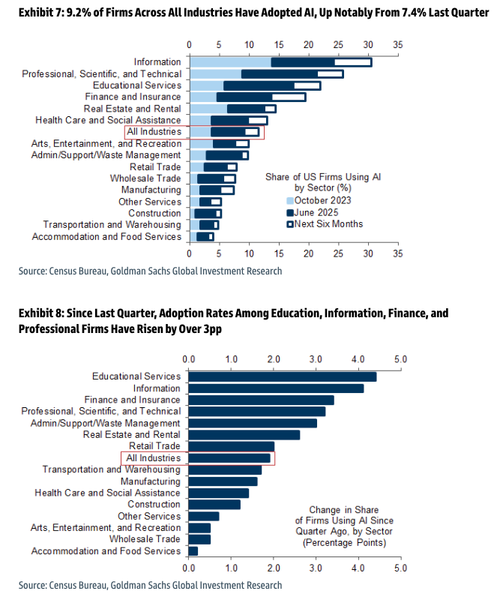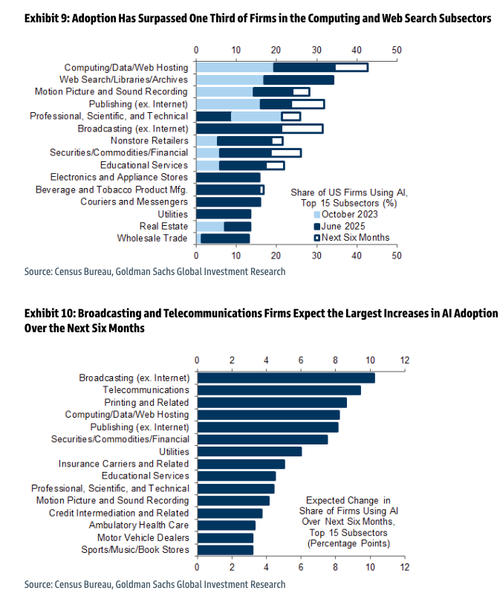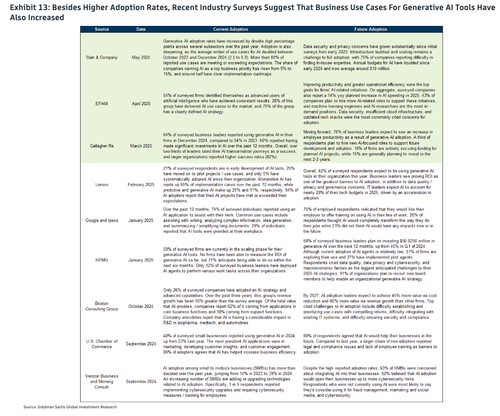No one is forced to be a Christian. But no one should be forced to live according to the "new religion" as though it alone were definitive and obligatory for all mankind.
Distinction Matter - Subscribed Feeds
-
Site: OnePeterFive

Above: Jesus Christ and Nicodemus by Matthias Stom (c. 1600 – after 1652) From the Roman office. ℣. Grant, Lord, a blessing. Benediction. May the Gospel’s holy lection Be our safety and protection. ℟. Amen. Reading 1 Continuation of the Holy Gospel according to John John 3:16-21 At that time, Jesus said unto Nicodemus: God so loved the world that He gave His Only-begotten Son…
-
Site: Zero Hedge'No ID, No Nudes': Pornhub Pulls Out Of France In Spat Over Age ChecksTyler Durden Mon, 06/09/2025 - 04:15
Vive la resistance - in reverse. Pornhub and its sister sites YouPorn and RedTube have gone dark in France, yanking access to their content Wednesday in a dramatic protest over a government crackdown on underage users.
 A screen displays a “no under-18s” sign in front of the logo of a pornographic website as regulators consider requiring such sites to ensure they are preventing minors from being exposed to their content. Lionel Bonaventure/AFP via Getty Images
A screen displays a “no under-18s” sign in front of the logo of a pornographic website as regulators consider requiring such sites to ensure they are preventing minors from being exposed to their content. Lionel Bonaventure/AFP via Getty Images
The move comes after Aylo - the firm behind the trio of X-rated titans - hit pause on its French operations rather than comply with a new law requiring porn platforms to verify users are 18 or older.
“I can confirm that Aylo has made the difficult decision to suspend access to its user-uploaded platforms... in France,” a Pornhub spokesperson said Tuesday. “We will be using our platforms to directly address the French public tomorrow.”
Aylo, which operates some of the world’s most trafficked adult sites, is now in a standoff with France’s digital watchdog, Arcom, which has the power to block sites and fine operators who fail to screen out minors.
French officials aren’t exactly begging them to stay.
“If Aylo would rather leave France than apply our laws, they are free to do so,” Clara Chappaz, France’s junior minister for artificial intelligence and digital technology, posted bluntly on X.
According to Arcom, some 2.3 million minors access porn sites every month in France - a clear violation of laws requiring age gating. The government has demanded stricter controls, like government ID or verified digital passports.
But Aylo claims the measures would compromise user privacy and create security risks, setting up a classic clash between data protection and content regulation.
Now, French users clicking over to Pornhub are getting nothing but a cold shower - a sudden blackout that leaves millions of adults scrambling for alternatives.
Whether the blackout is a temporary gambit or a long-term exit remains unclear. But one thing’s for sure: in France, the liberté to browse adult content just got a whole lot harder to come by.
-
Site: southern orders
Pope Francis would not do it, but Pope Leo has corrected the situation!Press title for Crux article:
Vatican website removes pictures of artwork created by priest accused of abuse
-
Site: AsiaNews.itToday's news: Chinese aircraft carrier Liaoning entersJapan's exclusive economic zone;Thailand and Cambodia movetheir border troops back to their previous positions;Malaysia has restricted travel for a cartoonist;More than half of mobilised population from one Siberian city killed onUkraine front.
-
Site: AsiaNews.itThe Berdymukhamedov government is mobilising to counter 'foreign centres of ideological sabotage' which, in its view, are fuelling protests. Public officials will have to go door to door in villages to gather stories about how well people live in the country. They will be accompanied by artists who will demonstrate their skills by singing or playing traditional instruments.
-
Site: Zero HedgeBulgaria Set To Join Eurozone In 2026Tyler Durden Mon, 06/09/2025 - 03:30
Authored by RFE/RL staff via OilPrice.com,
-
The European Commission has given Bulgaria the green light to adopt the euro as of January 1, 2026, following a positive assessment of the country's economic convergence.
-
Bulgaria's approval to join the eurozone represents a significant milestone in its broader integration into the European Union, following its recent entry into the Schengen Agreement.
-
Despite facing political and economic challenges, Bulgaria has met the necessary criteria for euro adoption, with final decisions to be made by the Council of the EU.
The European Commission has given Bulgaria the go-ahead to join the eurozone single currency region as of January 1, 2026, the country's second major step in just one year on its path to full integration into the European Union.
The commission, which met on June 4 to convey its decision on the issue, said Bulgaria fulfils the four nominal convergence criteria that are used to evaluate whether a country is ready for euro adoption.
"The euro is a tangible symbol of European strength and unity," said European Commission President Ursula von der Leyen.
The European Central Bank (ECB) also gave a positive assessment of Bulgaria's application, saying it met the criteria of currency stability, inflation, public finances, and interest rates.
“This positive assessment of convergence paves the way for Bulgaria to introduce the euro as of 1 January 2026 and become the 21st EU Member State to join the euro area,” Philip Lane, a member of the ECB Executive Board, said.
“I wish to congratulate Bulgaria on its tremendous dedication to making the adjustments needed.”
The Council of the EU will take the final decisions on euro adoption for Bulgaria, basing its decision on the opinions of the EC and the ECB, as well as from talks with the Eurogroup and European Council.
While adoption of the euro was a condition for joining the European Union, legislative failures, including reforms to combat money laundering, concerns over inflation, and political gridlock -- Bulgaria has had seven elections in the past four years -- have made the path difficult for the country.
Mass protests took place in Sofia and other cities across the country last week, and politicians said after the decision that the task now is to make sure adoption provides benefits, not disruption.
Prime Minister Rosen Zhelyazkov said the government would work to make "the process of introducing the euro smooth, predictable, predictable" and to dispel "the fears that are instilled in people and that are used for political abuse."
Added Boyko Borisov, leader of the GERB party and a former prime minister: "A huge amount of work lies ahead, especially next year, because Bulgarians should feel the benefits of the eurozone."
The decision in favor of adoption is Bulgaria’s second big step in just one year on its path to full integration into the European Union.
In January, Sofia became a full member of Schengen agreement -- and Bulgaria’s borders with neighboring Greece and Romania are now fully open.
-
-
Site: Mises InstituteAlex Pollock has questions for the Federal Reserve in the Financial Times.
-
Site: Mises InstituteCritics of the Free State Project should direct animosity, not at those moving to their state, but to the other 49 states for failing to be freer. The Free State Project migrants are not moving to New Hampshire to exert coercion on the existing population, but to live under less coercion.
-
Site: Zero Hedge73% Of Indonesian Men Smoke...Tyler Durden Mon, 06/09/2025 - 02:45
In 2025, smoking remains a persistent public health concern, with sharp disparities visible not only across countries but also between genders.
The World Health Organization estimates that tobacco use causes over 8 million premature deaths each year. Of these, more than 7 million are due to direct tobacco use, while around 1.3 million non-smokers die from exposure to second-hand smoke.
The graphic below, via Visual Capitalist's Marcus Lu, highlights the male and female smoking rates in ten major countries. The data is based on projections compiled by Statista.
Gender Disparities in Global Smoking Rates
The most striking contrast is seen in Indonesia, where nearly three-quarters (72.8%) of men are smokers, while just 1.8% of women partake.
This gender gap is also present in China (44.4% vs. 1.4%) and India (10.9% vs. 0.9%), reflecting cultural norms and targeted marketing practices.
In contrast, countries like France and Germany show much narrower disparities. France stands out with almost equal smoking rates among men (35.2%) and women (34.0%), suggesting a more gender-neutral culture around tobacco use.
Meanwhile, the U.S. and Japan fall in the mid-range, with moderate gender gaps and relatively lower overall smoking prevalence compared to Asian and European counterparts.
In Russia, 31.4% of men and 5.7% of women smoke, while in Brazil, smoking rates are lower, with 14.1% of men and 8.1% of women who smoke.
Raw tobacco production is a huge industry. In 2022 alone, around 5.8 million tons of tobacco were produced worldwide, roughly a third of which was in China. Learn more about tobacco production in this graphic on Voronoi, the new app from Visual Capitalist.
-
Site: Zero HedgeEU Farmer Protests Far From Over As They Battle Threats From Mercosur Trade Agreement And UkraineTyler Durden Mon, 06/09/2025 - 02:00
Farmers in Spain and France were again protesting agricultural imports from Ukraine and South America under the Mercosur trade agreement ahead of Brazilian President Luiz Inacio Lula da Silva visiting France and the expiration of a free trade agreement with Ukraine, writes TopAgrar.pl.
Da Silva wants to convince President Emmanuel Macron to drop his opposition to the EU-Mercosur Agreement, and at a press conference with the French head of state, told press that he would not “leave the Mercosur presidency without having concluded the trade deal,” a position he will be taking up in a few weeks.
Meanwhile, the French Federation of Agricultural Unions (FNSEA) has once again called on Macron to take action to create a minority in the EU to block the ratification of the Mercosur Agreement by the Council of the European Union.
In a statement quoted by Reuters, the French organization warned that the agreement will be “devastating for the beef, poultry and sugar industries and compromise the EU’s ambitions in terms of food sovereignty.”
“We are raising the alarm!” said Alain Carre, head of the French sugar industry group AIBS.
If an agreement with Mercosur is reached, the French are demanding clear trade rules: “Our demands (for an EU-Mercosur deal) are simple: reciprocity of regulations, traceability of products abroad and much clearer labeling,” said Jean-Michel Schaeffer, head of French poultry industry group Anvol.
In Spain, hundreds of farmers gathered in Madrid to protest excessive grain imports from Ukraine, which have resulted in grain prices below production costs.
“Spanish farmers will lose €1 billion this year,” Javier Fatas, leader of the farmers’ union COAG from the Aragon region in northeastern Spain, said.
Spaniards also refuse to import genetically modified grain from Mercosur, which is cheaper than Spanish grain, into the EU.
Similar sentiments are prevalent in Poland. In June, farmers took to the streets again to express opposition to trade liberalization with Ukraine, the Mercosur agreement, and the Green Deal, reminds TopAgrar.
“Our position should be firm and clear: the customs and limits from before the war must return. Otherwise, we will not be able to compete on the European market, and especially in Poland,” said Stanisław Barna from the grassroots All-Poland Farmers’ Protest.
At the protest in Krążkowy in Wielkopolska, another OOPR representative, Krzysztof Olejnik, called the provisions of the EU-Mercosur Agreement a “spit in the face” of farmers: “If we are talking about Mercosur, we still do not have detailed information about the terms of this agreement. We assume that the terms of this agreement will probably not be favorable for us,” said Krzysztof Olejnik.
The lack of hope for economic improvement in agriculture is combined with a sense of lack of action on the part of the Ministry of Agriculture, the Government and the European Commission. Maciej Zawadzki from the Association of Farmers of Southern Wielkopolska said, “We decided to take to the streets because our issues that were supposed to be resolved are still unresolved. The government remains passive. (…) Unfortunately, we do not see any actions that would improve our position and situation. Quite the opposite: what is happening is working to our disadvantage.”
Stanisław Barna says the only option for farmers now is to put pressure on decision-makers via protests.
“We want to work with dignity, have a stable situation. Have a decent salary for our work (…) This is what we are reduced to, to make our farms fail. If you do not fight for yourselves, no one will do it for you! Thank you and God bless you for your determination and showing strength today. Let the government see, and Minister Siekierski will finally get down to work, because he has been talking to us for a year and a half, saying that he will prepare a position, but let him finally come to West Pomerania and talk,” he said.
Farmers also hope the newly elected president, Karol Nawrocki, will come through for them. “Mr. President, we are here, we are watching, we are waiting for your decision,” Barna added. “We farmers would like these promises to be fulfilled and not forgotten.”
Macron and Lula did not appear to make much headway on EU-Mercosur trade deal. Macron clearly wants to boost trade and relations with Brazil but he also made clear that he cannot accept the deal in its current form, emphasizing the need for “either mirror clauses or safeguard measures” to ensure Brazilian products conform with EU production standards.
-
Site: The Unz ReviewI have never understood why rioters, protestors, whatever you want to call them, burn people’s cars. Insurance seldom covers such events. Violent protests harm innocents. I also don’t understand why the National Guard is called out as they are not permitted to use their weapons. Try to imagine the National Guard using deadly force to...
-
Site: The Unz ReviewPresident Donald Trump is threatening to launch air strikes on Iran for activities that are approved under the terms of Iran's treaty obligations. This is not a matter on which there should be any debate. The Treaty on the Non-Proliferation of Nuclear Weapons (NPT) explicitly grants all parties, including Iran, the “inalienable right” to develop,...
-
Site: AntiWar.comRecent reports say that US AID is considering giving $500 million to the Gaza Humanitarian Foundation (GHF) – an “aid” initiative launched at Israel’s request. At first glance, that might sound like a generous effort to help desperate Palestinians in Gaza. But peel back even one layer, and you’ll find a deadly political scheme masquerading … Continue reading "Don’t Fund the Gaza Humanitarian Foundation: It’s a Genocidal Smokescreen"
-
Site: The Unz ReviewPutin avoided the dire consequences mandated by Russian war doctrine by labeling the attack on Russia’s strategic triad a “terrorist act,” not an act of war. This has delayed, but not prevented a wider and more dangerous war, because what Putin has actually done is to eviscerate Russian war doctrine. If the President of Russia...
-
Site: The Unz ReviewThe silence of the bears will soon be ended and we will know more about Russian resolve. Russia’s leadership is in ‘conclave’ determining its riposte. Trump has been silent for two days. Unprecedented. In the last days, Ukraine and its facilitators attempted a massive attack on Russia’s strategic nuclear bomber-force; succeeded in collapsing two bridges...
-
Site: The Unz ReviewAbout a year ago, I first began exploring the powerful new AI systems that had been receiving so much public attention, and incorporated some of their features into our website. For myself and many of our other writers, I added focused chatbots that used the corpus of the written works hosted on our website to...
-
Site: AntiWar.comThe European Union thought the 2023 election of Donald Tusk as Prime Minister of Poland solved their Poland problem. But the June 2 election of Karol Nawrocki as President shows they were wrong. Nawrocki is a Euro-skeptic who has aligned himself with U.S. President Donald Trump’s agenda more than with the EU’s agenda. He is … Continue reading "Does Ukraine Now Have a Poland Problem?"
-
Site: AntiWar.comScott Horton’s speech to the Tbilisi Summer Forum on June 6th No offense, but Georgia’s interests are just none of my affair. It’s such a long way from here. I know my government has been messing around there since the 1990s, picking winners and losers, making big promises and causing lots of trouble. Keeping Russia … Continue reading "A Message to Georgians: America Will Not Protect You"
-
Site: Zero HedgeRestoring American Maritime Dominance: A National ImperativeTyler Durden Sun, 06/08/2025 - 23:20
Authored by Andy Thaxton via RealClearWire,
As a career Naval intelligence officer, I spent years observing China’s maritime ascent. Briefing after briefing warned of China’s increasingly aggressive intentions of seapower, and yet, all that analytical churn has had negligible impact on U.S. naval posture. Now, watching from the sidelines, I remain alarmed by the widening gap between the naval and shipbuilding capabilities of the United States and the People’s Republic of China. What once was a slow, methodical buildup by the Chinese People’s Liberation Army Navy (PLAN) has accelerated into a rapidly growing strategic threat to U.S. maritime supremacy—both commercially and militarily. Without exaggeration, the United States is facing an urgent national security crisis.
While the U.S. rested on the laurels of its past naval dominance, China has systematically executed a comprehensive, state-directed maritime strategy that is now reshaping the global balance of naval power.
If the U.S. fails to respond with urgency and scale, we risk ceding control of the seas—and with it, the geopolitical influence that flows from maritime power.
The data is staggering. According to the April 2025 Report to Congress on Chinese Naval Modernization, China’s navy currently operates over 370 battle force ships, a number projected to grow to 435 by 2030. Meanwhile, the U.S. Navy is struggling to maintain around 290 ships, with ambitions—still largely unfunded—of reaching 316 by 2053. Equally alarming, China’s shipyards possess more than 230 times the shipbuilding capacity of the U.S. According to a recent report by The Center for Strategic and International Studies (CSIS), China “built more commercial vessels by tonnage in 2024 than the entire U.S. shipbuilding industry has built since the end of World War II.” You might want to read that sentence again.
But the disparity is not merely in tonnage or hulls. China’s state-supported shipbuilding industry benefits from over 150 shipyards, including eight major naval production sites capable of building large warships, aircraft carriers, and amphibious assault ships in parallel. In stark contrast, the U.S. Navy is dependent on just seven private shipyards, several of which are overburdened, outdated, and struggling with workforce shortages. Further, the Congressional Report on U.S. Navy Force Structure indicated that nearly every major U.S. shipbuilding program is behind schedule and over budget.
Meanwhile, China’s maritime ambitions have expanded beyond the Indo-Pacific. As documented in the December 2024 U.S. Naval Institute Proceedings, China’s global maritime reach now spans 10,000 miles beyond Taiwan, including permanent naval bases in Djibouti and increasing influence in ports across Pakistan, Cambodia, and Equatorial Guinea. The foundation of this expansion is China’s merchant fleet—the world’s largest—which can be rapidly converted to military use in a real-world shooting war. Again, by contrast, the U.S. merchant fleet has dwindled to fewer than 180 international trading ships, severely limiting sealift capacity in a contested environment.
Taken together, this paints a picture of a maritime balance that is tipping rapidly and dangerously toward Beijing. Initiatives such as President Trump’s Executive Order on Restoring Maritime Dominance and the reintroduction of the SHIPS Act signal a growing recognition of the problem, but they are insufficient in both scale and urgency. Rebuilding a competitive naval force cannot be done incrementally or through bureaucratic half-measures.
The United States must enact a modern-day Marshall Plan for shipbuilding, one rooted in the understanding that maritime supremacy is the backbone of American global power. The plan must be bold, multifaceted, and sustained. Five critical priorities stand out:
-
Massive Industrial Investment: As proposed in the SHIPS Act, Congress must allocate $20–30 billion over the next decade to modernize and expand U.S. shipyards—revitalizing dry docks, increasing capacity, and restoring tiered supplier networks. Geographic diversification of shipyards is also critical to ensure resilience in a conflict.
-
Workforce Development: The U.S. faces a massive shortage of skilled labor in shipbuilding. The government should launch a unified Maritime Workforce Initiative, partnering with trade schools, unions, and community colleges to train tens of thousands of welders, electricians, engineers, and naval architects.
-
Procurement Reform: The Navy’s acquisition system must be radically—let me repeat, radically—overhauled. The complex, inefficient cost-plus contract system has made U.S. shipbuilding painfully slow and expensive. The Navy should adopt simpler, modular designs that speed up production, reduce costs, and make the fleet more adaptable.
-
Dual-Use Shipbuilding: The U.S. should incentivize the construction of commercial ships—tankers and container vessels—at domestic yards. This will boost shipyard throughput, maintain a steady workforce, and provide an auxiliary fleet in times of war.
-
Strategic Messaging and Public Buy-In: Maritime security is fundamental to national prosperity and defense. A public campaign, similar to the WWII-era “Victory Ship” program, could make shipbuilding a patriotic endeavor and reinvigorate public support for maritime dominance.
This is not hyperbole; the situation is dire. U.S. naval leaders have privately acknowledged a “worst-case scenario” in which the Navy may not be able to reliably contest Chinese aggression in the Western Pacific within the next five years. If the U.S. fails to act now, or fails to act boldly, we will not only lose our naval edge but forfeit our ability to shape the international order.
The oceans have always been the lifeblood of American power. In the 20th century, our shipbuilding might help win world wars and deter Soviet aggression. In the 21st century, it will determine whether we remain on the field as a superpower, or, like me, retire to the sidelines as an observer, in an era defined by Chinese maritime dominance. The time for incremental fixes is over. The clock is ticking—and only an “all-hands-on-deck” national response will suffice.
-
-
Site: Zero HedgeWashington DC Dominates The US Gun-Deaths LeagueTyler Durden Sun, 06/08/2025 - 22:45
Gun violence remains one of the most pressing public health issues in the United States.
But as Visual Capitalist;s Bruno Venditti shws in the following chart, according to data from USAFacts as of December 2023, gun-related deaths vary significantly across states, reflecting long-standing regional and demographic differences.
Preliminary numbers show that between January and August 2024, an estimated 30,100 people died from gun-related injuries in the U.S., 5% fewer than during the same period in 2023.
The rate of gun-related deaths in the U.S. has shifted over time. In the early 1990s, the rate fluctuated between 14.5 and 15.0 deaths per 100,000 people. From 2000 to 2014, however, that figure declined and remained below 10.5 deaths per 100,000.
By 2023, the rate rose again to 13.7 per 100,000—still 8% lower than its peak in 1993.
States With the Highest Gun Death Rates
Washington, DC recorded the highest rate in the country in 2023, with 28.5 deaths per 100,000 residents, more than 60% above the next highest state.
States With the Lowest Gun Death Rates
At the other end of the spectrum, several states reported significantly lower rates. Those include Hawaii, Utah, and Nebraska.
Although they receive less public attention than gun-related homicides, suicides have consistently made up the majority of gun deaths in the United States. In 2023, suicides accounted for 58% of all gun-related fatalities, totaling 27,300 deaths, according to CDC data. By comparison, 38% were classified as murders (17,927 deaths).
The U.S. has more guns than people, with nearly 400 million in civilian possession. In this map, we rank states by the highest percentage of gun ownership for adults.
-
Site: Euthanasia Prevention CoalitionAlex Schadenberg
Executive Director, Euthanasia Prevention Coalition
New York, assisted suicide Bill A136/S138 passed in the New York Assembly by a vote of 81 to 67 on April 29 and may soon be debated in the state Senate. We have urged supporters to contact the members of the New York State Senate.
The New York bill is particularly loose in it's language. But what makes New York's bill even more egregious is that:
1. The bill does not have a reflecton period. A person's bad day can be their last day.
The bill requires the person to have the assessor confirm that there is a "terminal condition" with a 6 month prognosis to die. "Terminal condition" includes diabetes and eating disorders. Without a reflection period, there is no opportunity to rethink the deadly irreversible decision.
2. There is no residency requirement. The New York bill allows anyone from anywhere to die by assisted suicide in New York.The New York assisted suicide bill may come up as early as TOMORROW (Monday) for a floor vote.Senator Name Email Albany OfficeAndrea Stewart-Cousins scousins@nysenate.gov 518-455-2585Andrew Gounardes gounardes@nysenate.gov 518-455-3270Brian Kavanagh kavanagh@nysenate.gov 518-455-2625Jamaal Bailey senatorjbailey@nysenate.gov 518-455-2061John Liu liu@nysenate.gov 518-455-2210Joseph Addabbo addabbo@nysenate.gov 518-455-2322Kevin Parker parker@nysenate.gov 518-455-2580Patricia Fahy Fahy@nysenate.gov 518-455-2225Shelley Mayer smayer@nysenate.gov 518-455-2031Toby Ann Stavisky stavisky@nysenate.gov 518-455-3461Tell them that you oppose assisted suicide and this assisted suicide bill is particularly dangerous because it lacks a reflection period and there is no residency requirement.Because the New York bill does not have a residency requirement, all of our loved ones are at risk from the dangers of assisted suicide passing in New York State even if they don't live there. Remember, when assisted suicide bills pass, it is often by just one or two votes. Your voice really does make a difference!As bad as the New York assisted suicide bill is the assisted suicide lobby has expanded existing assisted suicide legislation in nearly every state that has legalized assisted suicide.Oregon allows physicians to wave the waiting period and Oregon has also eliminated the residency requirement. Vermont is permitting assisted suicide by telehealth, they are forcing medical practitioners who oppose assisted suicide to refer patients and they eliminated the residency requirement. Washington state, California, Colorado and Hawaii have also expanded their assisted suicide laws.
Once assisted suicide is legal, the assisted suicide lobby will work to further expand the law. The original assisted suicide bill is designed to pass in the legislature, once passed incremental extensions will follow.
-
Site: Zero HedgeAI Is Taking Thousands Of Jobs; Is Yours At Risk?Tyler Durden Sun, 06/08/2025 - 21:00
Authored by Autumn Spredemann via The Epoch Times,
Just as the internet radically changed how America conducts business, artificial intelligence (AI) is also making waves in the workplace by taking thousands of jobs. It’s an outcome that industry experts have warned would happen, and professionals across multiple employment sectors have already been affected.
Beyond artists and content creators, AI is also impacting professionals in marketing, technology, translation, various levels of administration, and management. It has been a silent and ongoing trend for two years, but tech insiders say this is just the beginning.
A senior software engineer at Microsoft, Nandita Giri, shared her thoughts with The Epoch Times on what kind of near-term changes Americans can expect as a result of ramped-up workplace AI integration.
“AI is particularly effective at replacing routine, predictable tasks ... jobs in data entry, customer support, transcription, and logistics are the most vulnerable,” Giri said. “In software engineering, even some junior [developer] testing roles are being replaced or reshaped with AI-driven tooling. Back-office operations across health care, finance, and legal are also at high risk.”
Giri has observed a shift away from human workers in favor of AI in enterprise software development, where she said companies are quietly removing what they call “coordination overhead.” She said this is happening as AI tools become more reliable for things like task triage, scheduling, and summarization.
“AI agents have enabled a single engineer to manage what used to be a multi-person workflow, especially in automation pipelines and internal support tasks,” she said.
Restructuring Workflow
Cahyo Subroto, founder of the AI-powered data extraction platform MrScraper, agrees with this perspective.
“I’ve spent the last few years building systems that automate work, so I’ve seen firsthand where AI adds value and where it quietly pushes people out of the picture,” Subroto told The Epoch Times.
Like Giri, Subroto said that the jobs most in danger of AI replacement are those that rely heavily on structured, repetitive digital labor.
“That includes early-stage analysts, junior QA [quality assurance] testers, data entry staff, and even support roles in HR and customer service,” he said.
Subroto explained that when AI can learn workflow patterns, it can perform them faster and without the payroll cost. “At my last company, I watched a client eliminate three QA positions after switching to a tool that could auto-generate test cases and report bugs in real time.”
These decisions are based strictly on efficiency, he added. “That’s what makes this shift so difficult to stop.”
In January, the World Economic Forum (WEF) released a report that estimated 92 million jobs would be displaced by AI by 2030. The think tank surveyed more than 1,000 of the world’s largest employers, accounting for 22 industry groups and more than 14 million workers.
There is a silver lining, however. The WEF—and many others—predict that AI will also create new jobs and reshape existing positions, allowing current employees in various sectors to focus on more high-value tasks instead of routine work.
A robot sprinkles cheese over a pizza at the Institute for Artificial Intelligence of the University of Bremen, Germany, on March 8, 2017. Ingo Wagner/dpa/AFP via Getty Images
Jobs with declining demand include customer service representatives, claims adjusters, bank tellers, graphic designers, accountants, and auditors, the WEF report said.
Subroto believes much of the shift toward AI will be subtle. “Instead of replacing people, we’re restructuring the workflow to rely on AI for the mechanical parts, while humans take on broader accountability.”
“That’s a harder conversation because it’s not about job loss. It’s about job transformation, and not everyone will be equipped and ready to make that jump,” he said.
Big Changes Ahead
In May, Microsoft announced plans to lay off 3 percent of its employees across the board, affecting roughly 6,000 people. In a statement to CNBC, a spokesperson for the tech giant said, “We continue to implement organizational changes necessary to best position the company for success in a dynamic marketplace.” The spokesperson confirmed that the job cuts weren’t related to worker performance.
It’s reportedly the largest series of layoffs at Microsoft since 2023.
This arrives on the heels of reported cuts at Amazon, which in January said it would lay off what it called a “small number” of its communications and sustainability employees. It followed that by announcing in March plans to eliminate 14,000 managerial positions by early next year.
Among those who lost their job at Microsoft is former senior data scientist Tatiana Teppoeva, founder and CEO of One Nonverbal Ecosystem. She told The Epoch Times that increased tech layoffs alongside the rise of AI integration is an industry red flag.
“This has sparked genuine concerns over the future need for human programmers and signals a real, accelerating shift in how companies evaluate which human roles are essential,” Teppoeva said.
Like Giri and Subroto, Teppoeva identified industries that have a lot of unchanging, rules-based tasks like back-end software development, data entry, finance, and logistics as areas with a high probability of AI job replacement.
“The most realistic near-term disruption is task-level automation, not full job replacement,” she said. “For example, in sales, AI tools can draft outreach emails or analyze deal data, but they cannot replicate the human-to-human trust, nonverbal signals, and presence that close high-ticket deals.”
Teppoeva said the human-AI gap is now a point of focus for her business. “Helping sales teams, executives, and companies align their human communication, body language, voice, [and] nonverbal presence [is] what advanced AI tools still can’t do,” she said, then added, “At least not yet.”
On June 2, a Midwest-based web content manager for a major U.S. company—who asked to be identified only as “Tom”—was laid off with the rest of his department and most of the company’s marketing staff. Tom requested the company not be identified out of fear it could affect his severance.
Having worked in web development for more than 15 years, Tom said he saw the “AI blitz” coming and had a gut hunch it would only be a matter of time before he was made redundant.
“The worst part is the lack of honesty,” Tom said. “Companies aren’t being straight with people, they’re just saying things like ’sales are down‘ or ’we need to improve efficiency,' but the reality is it’s about increasing profit by any means.”
Tom said he has a friend who spent nearly two decades working in marketing and kept up with changing industry trends before being laid off a year ago because of AI integration.
“There are entire careers with university degrees behind them that are ending now,” Tom said.
“It’s not necessarily a one-to-one ratio,” he added. “Maybe an AI tool automates half of a department’s workload. That means you can redistribute the remaining work amongst a smaller team.”
Since the Hollywood writers’ strike in 2023, the potential for AI to disrupt careers has been under a microscope, and it’s easy to see why. Out of more than 80,000 jobs cut in May 2023, nearly 4,000 were due to AI, according to a layoffs report from the outplacement firm Challenger, Gray, and Christmas, Inc.
The trend continued last year. In 2024, the Society of Authors surveyed 12,500 workers in different creative industries, revealing many had already lost work to AI. According to the survey, 26 percent of illustrators and 36 percent of translators had already lost work because of generative AI.
Tesla co-founder Elon Musk also shared his views on AI job replacement during the Viva Technology conference in Paris in 2024, following news that Tesla planned to lay off 10 percent of its workforce.
A 3D-printed miniature model of Elon Musk and the Tesla logo are seen in this image from Jan. 23, 2025. Dado Ruvic/Illustration/Reuters
“If the computer and robot can do everything better than you, what meaning does your life have? ... In a negative scenario ... we’re in deep trouble,” Musk said.
Other tech insiders share this point of view. During an episode of “The Artificial Intelligence” show, Marketing AI Institute founder Paul Roetzer said AI is fundamentally reshaping the human workforce.
“It’s not like we’re drawing some difficult-to-find conclusion here,” Roetzer said when discussing Microsoft’s most recent layoffs. “If the CTO [chief technology officer] of the company is saying that within five years we expect 95 percent of all code to be written by AI, then what do you need a bunch of engineers for?”
Subroto used an example from his work, describing the use of AI for “task sequencing and code generation,” which allowed his company to launch features faster and fix bugs before users even saw them. However, he said the improved work efficiency came at the cost of no longer needing manual testers checking outputs line by line.
“These were smart, capable people, and yet the structure of the work changed so much that their role no longer made sense,” he said.
The current phase-out of human work roles due to increased AI efficiency is nuanced, but some don’t think it will stay that way for much longer.
A McKinsey Global Institute analysis from July 2023 predicted that 30 percent of total hours worked could be absorbed by generative AI by 2030. Researchers estimated that 11.8 million employees working in sectors with shrinking demand may need to shift into other departments, while roughly 9 million may need to change careers entirely.
-
Site: Zero HedgeLost To History: The Forgotten Thermonuclear Near-Disaster On Big Savage MountainTyler Durden Sun, 06/08/2025 - 20:25
Six decades ago, in a near-nuclear disaster erased from public memory, a U.S. Air Force B-52D Stratofortress—carrying two thermonuclear bombs—was torn apart six miles above the Appalachian Mountains. The aircraft's vertical stabilizer snapped off mid-flight, sending the bomber into an uncontrollable dive before it slammed into Big Savage Mountain in Western Maryland. The crash marked one of the closest nuclear near-misses on U.S. soil during the Cold War.
On January 13, 1964, a B-52D Stratofortress took off from Westover Air Force Base in Massachusetts en route to Turner Air Force Base in Georgia as part of a Strategic Air Command mission called "Operation Chrome Dome." On board were five crew members and two thermonuclear bombs.
A heavily redacted USAF report on the mid-air accident of the nuclear-laden B-52D specified that a bulkhead structural failure occurred during severe turbulence that caused the vertical fin to separate.
As the bomber broke up in mid-air, the pilot, Major Thomas McCormick, and co-pilot Captain Parker Peedin ejected and survived. However, three other crew members perished:
-
Major Robert Townley (died in the crash)
-
Tech Sgt. Melvin Wooten (died from injuries and exposure)
-
Major Robert Payne (died from exposure after ejecting)
The crash drew national attention and mobilized hundreds of local volunteers for search and rescue efforts despite dangerous blizzard conditions across the Big Savage Mountain.
In 2014, Politico interviewed Gerald Beachy of the Grantsville Community Museum, which amassed a collection of crash memorabilia and wreckage from the bomber, who said it took USAF salvage operations several days to recover the thermonuclear bombs from the remote crash site.
The incident in the remote mountains of Western Maryland has been largely erased from public memory. It occurred at the height of the Cold War—just two years after the Cuban Missile Crisis. This wasn't merely an air crash; it stands as one of the most serious nuclear weapons-related accidents on U.S. soil, even though the warheads were unarmed.
Reminders of the past are crucial as the nation braces for the 2030s—a decade in which the world is expected to fracture into a dangerous bipolar state, accelerating at an unprecedented pace.
Meanwhile, Europe is unleashing massive efforts to rebuild weapons stockpiles and scale up war readiness amid the ongoing war in Eastern Europe. Meanwhile, in the U.S., the Trump administration is accelerating plans to expand defense capabilities and bolster hemispheric defense. The arms and technology race with China is no longer in snail mode—it's in full-blown hyperdrive, and with that comes many risks.
-
-
Site: Public Discourse
We’ve seen it all before. The Canadian Conservative Party squanders a commanding lead as the liberals quietly adopt its core economic policies—lower taxes, modest spending restraint, skepticism toward the carbon tax—while taking a slightly more moderate tack on social issues. Donald Trump was a key factor in the election outcome this round, but the reality is that Liberal Party leader Mark Carney’s platform mirrored the core of what the right typically campaigns on, and as has been the case in the past, a slight nod in that direction is often enough to see the conservatives’ distinctiveness evaporate. The shallowness of the conservative offering becomes painfully apparent. As John Ibbitson recently noted, the parties ended up looking like Tweedledee and Tweedledum. This reality has been borne out in the first few actions of the new liberal government, both in the mandate letter (whose priorities include balancing the budget, reducing immigration levels, and eliminating interprovincial trade barriers) and the Speech from the Throne, which committed to meeting NATO’s 2 percent defense spending target, to public safety messaging, and to enhancing national sovereignty through military and Arctic investments. It shows that the so-called conservative position was never deeply conservative at all—it is merely a variation on liberalism, as it was ten or twenty years ago.
If Canadian conservatism is to become anything more than a periodic managerial alternative, it must cultivate a long game to change culture and the courage to offer a truly differentiated vision; otherwise it will continue to be seen by Canadians for what it is: liberalism with a lag.
Liberalism in Conservative Clothing: A Century of Failed Imitation
Canada’s century-long political trajectory proves the point. Conservatives in Canada have never been natural cultural or political leaders. From free trade and multiculturalism to same-sex marriage, from the Charter of Rights and Freedoms to enthusiastic support for high levels of immigration and qualified endorsement of diversity initiatives, conservatives have not resisted liberal ideas but merely endorsed them after a delay.
This is not a criticism of the party’s performance in this election, as it earned its highest share of the popular vote as the modern conservative party. And regardless of how you feel about any of these issues, the point is that if you zoom out, you can see the problem is more systemic.
Part of the failure stems from an excessive emphasis within conservatism on libertarian social freedom—the exaltation of personal choice and autonomy as supreme goods. Postwar “fusionism” attempted to combine these instincts with traditional moral foundations but never fully resolved their contradictions. Friedrich Hayek—a hero to many conservatives—is illustrative of this tension; he insisted that he was not a conservative and warned of the inherent difficulties in combining such principles. In “Why I Am Not a Conservative,” Hayek wrote that the conservatives’ respect for and deference to established authority troubles him, and that conservatives must feel as though someone is supervising change and keeping it orderly. He writes that they often rely on figures like Tocqueville, Lord Acton, and Burke to justify their positions—who themselves would have “shuddered” to be seen as Tories. Indeed, this heavy liberal influence is all too common among self-described conservatives, although often unbeknownst to them.
Liberalism’s Logical End: From Autonomy to Alienation
Unchecked liberalism has frayed civic and family life. It’s contributed to declining birth rates, splintered social fabric, and lower social trust from excessive immigration and unwieldy diversity, widespread loneliness, and a moral relativism that corrodes the pursuit of a coherent common good. After a century of emphasizing autonomy, the human person is today rootless and atomized.
Some argue that the solution is a more serious classical liberalism. But classical liberalism grew up within a thick cultural matrix—shared faith, strong family and social ties, a communitarian environment, and common national identity—that it has since eroded. Without that rich cultural soil, liberalism alone morphs into relativism. Moreover, what we are seeing today is not a betrayal of liberalism by “wokeness,” but liberalism arriving at its logical endpoint. A political and moral order that treats individual autonomy as the highest good must continually validate ever more divergent and incompatible lifestyles. If not properly balanced by other values, liberalism’s internal logic inevitably leads not to stable pluralism, but to balkanization and the dilution of shared principles and common life.
Focusing myopically on winning elections by tacking either more socially progressive or conservative guarantees only minor, temporary adjustments. Without cultural strategy, conservatism merely manages liberal decline without changing the long-term trajectory.
It is beyond question that the cultural excesses we see today are not failures of liberalism, but its logical conclusions. Hyper-individualism, instantaneous, unfiltered and constant communication, uninhibited social mores, postmodern relativism, and celebration of selfish desire—all of these were promised by progressives as paths to liberation and fulfillment. Instead, they have become sources of alienation, confusion, and cultural decay.
Decadent Status Quo: When Progressivism Becomes the Establishment
This is not just a Canadian problem. Hyper-individualistic liberalism is now the dominant culture across the West. Conservatives are no longer conserving traditional values and a more conservative society—they are conserving the remnants left behind by an overemphasis on some of liberalism’s core tenets, without appropriate balance from values equally important to human well-being: loyalty, reverence, moral vision, patriotism, and social trust rooted in shared commitments and beliefs.
Ironically, Donald Trump—a lifelong Democrat, a Manhattan social liberal on nearly every issue—is himself a product of this cultural milieu. He embodies rather than rejects the post-1960s order. His persona, rooted in self-promotion, celebrity, and the rejection of norms, mirrors the very values the cultural left has celebrated for decades.
In many ways, Trump represents the culmination of postmodernism’s ethos: the triumph of subjectivity over truth, power over principle, and narrative performance over moral integrity. He is not a conservative; he is the logical product of a culture that treats all identities, impulses, and truths as equally valid. And while his administration achieved more in 100 days than decades of lukewarm conservatism, that is more a testament to the failures of establishment conservatism and Trump’s outsider and entrepreneurial instincts than to his philosophical coherence.
Demographic shifts, such as the working-class realignment and the rightward movement of younger voters, point to the fact that we are undergoing a social shift, an inversion of what’s been typical. Defending the status quo—a procedurally conservative action—is a now a vote for liberalism and liberals. Those who favor the status quo are the wealthy, established, and older demographics, and those on the outside (the working class and younger voters) advocate change, which is now, paradoxically, to advocate conservative principles and likely to vote Conservative.
Traditionally non-conservative classes of people are waking up to the fact that the status quo is not working for them, due to the excesses of hyper-individualistic liberalism. The time is ripe for change. A conservatism of ideals must reject Trump-style decadent cultural populism just as it rejects the ideological excesses of progressive liberalism. It must be rooted not in personality or performance, but in truth, virtue, and the common good.
The Case for a Conservatism of Ideals
First, conservatives can strive to emulate serious long-term cultural efforts, like the Federalist Society’s reshaping of legal philosophy in the United States, Britain’s Policy Exchange, or France’s Cercle Aristote. These institutions patiently shaped professions, policy, and national narratives, not just electoral wins. In Canada, there is an opportunity in existing organizations like the Canada Strong and Free Network, which consistently underperforms in this regard. It could make much more of its “Conservative values tomorrow” mentoring program that I helped start, to have long-term, multigenerational impact.
Second, this conservatism must be communitarian and virtue-oriented. It must affirm the family as the first polity, the neighborhood as the beginnings of solidarity, and virtue—not just credentials and quantified results—as the currency of trust. People are profoundly hungry for these things, as antidotes to rootlessness, anomie, and increasing social isolation and loneliness.
Third, it must be genuinely progressive in the true sense: aiming to fulfill the unrealized human potential to live well, according to objective norms that we know are good for people—things like seeking transcendent experiences through faith and philosophy, cultivating family and friendships, balancing work and life, and imbuing both with a sense of vocation. It must recognize not an endless array of choices and diversity, but that there are certain things that are conducive to our well-being, and that, conversely, other things are objectively damaging to both individuals and communities. Liberalism’s attitude of “to each their own” leaves us in a dark place when people want to overdose on opioids, instruct a doctor to take their life, or mutilate their undeveloped body. In contrast to these plainly destructive policies springing out of the excesses of liberalism, conservatism should show that human life has a clear and understandable purpose, meaning, and a telos beyond itself.
This is the conservatism we need: not nostalgia and anachronistic social conservatism, not progressive liberalism with better branding, but a bold conservatism of clearly articulated ideals for human flourishing. Canada—and the West—desperately need such a vision. The only question is whether conservatives will have the courage to embrace it, and the wherewithal to see it through in the long term.
Image licensed via Adobe Stock.
-
Site: Euthanasia Prevention CoalitionAlex Schadenberg
Executive Director, Euthanasia Prevention Coalition Roger Foley lives at the LHSC
Roger Foley lives at the LHSC
Last week, a friend and I visited Roger Foley, who has been living at the London Health Sciences Centre (LHSC) for more than 9 years. Roger lives with cerebellar ataxia, a degenerative neurological condition.Living in a hospital means that Roger lives in a small room without the freedom to control his environment. To make matters worse, the hospital staff have asked him, on several occasions, about MAiD and they have regularly broached the topic of suicide.Roger, who I have been communicating with for several years, does not want to live in the hospital. Roger has served his time and deserves to be sent home. The catch is that based on his disability he needs significant care.Roger proposed, from the beginning, that he be sent home with self-directed care, meaning that Roger would hire the care team to provide for his needs. Self-directed care is a program that exists in Ontario, but Roger has been denied access to the program.Roger was offered care that would be provided through a "care agency". In the past when Roger's care was provided by a care agency he was not in control of his care team which resulted in several horrific experiences including food poisoning and a care giver falling to sleep while he was in the bath, to name a few. Remember, he can't get out of the bath without assistance.Further to that, when you do the math, self-directed care is the least expensive and preferable option for care.
The hospital is an incredibly expensive place to care for Roger and he does not want to be there. "Care agencies" bill the government for the cost of the care and the costs associated with the agency.
Self-directed care, whereby Roger would hire his own care team, is the least expensive and the preferable option since most of the cost is limited to the cost of the care team.
It is time to release Roger from the confinement of the hospital room and send him home with self-directed care. Roger has already created a proposed model of care that outlines the requirements of his team and the cost associated with his care.
Roger deserves to be sent home and be approved for self-directed care. -
Site: non veni pacem
Traveling relentlessly all weekend. But Pentecost at St James, West End (SSPX) was glorious. Happy feast!

-
Site: Zero HedgeWe Need A 'Kill Switch' On Foreign Powers Tampering With Our Electric GridTyler Durden Sun, 06/08/2025 - 19:50
Authored by Gary Abernathy via The Empowerment Alliance,
It has long been acknowledged that the United States’ energy infrastructure isn’t particularly secure, a concern exacerbated by the lack of a central planning process for our nation’s piecemeal electric grid. Presidential administrations and Congress have been slow to address the problem, apparently daunted by the mere size and scope of the challenges the needed upgrades would present.
That needs to change now. The recent news that China apparently installed hidden “kill switches” in solar equipment sold to the U.S. was the latest in a long list of reasons to be concerned about our electricity infrastructure and the foolhardy rush to replace traditional energy sources with so-called “renewables” using technology that is often sourced from China.
As Reuters reported, “Rogue communication devices not listed in product documents have been found in some Chinese solar power inverters by U.S experts who strip down equipment hooked up to grids to check for security issues … Using the rogue communication devices to skirt firewalls and switch off inverters remotely, or change their settings, could destabilize power grids, damage energy infrastructure, and trigger widespread blackouts, experts said.”
As one source summarized it, “That effectively means there is a built-in way to physically destroy the grid.” Or, to put it in even simpler terms, the U.S. is purchasing Chinese equipment complete with a “kill switch” that would allow China to disable the U.S. power grid at any moment.
Even more concerning, the problem is not relegated to the United States. Britain’s GB News reported, “Chinese companies dominate the market for power inverters, with firms like Huawei and Sungrow controlling more than half the market in 2023, according to Wood Mackenzie research. The European Solar Manufacturing Council estimates that more than 200 gigawatts of European solar power capacity relies on Chinese-made inverters.” (One gigawatt is equal to one billion watts.)
As Christoph Podewils, the council’s secretary general, put it, “This means Europe has effectively surrendered remote control of a vast portion of its electricity infrastructure.”
The Chinese embassy in Washington dismissed the allegation.
The relatively sparse news coverage of this startling discovery is evidence of either the mainstream media’s complacency, or its intentional effort to downplay any development that might contradict its radical climate change narrative. Surely, this item led the evening newscasts on ABC, CBS and NBC, right? Sadly, no.
If ever there was a wakeup call regarding the urgent need for the U.S. to be even more committed to energy independence, it has arrived in the form of China’s ability to remotely turn off the U.S. power grid.
Fortunately, President Trump is working hard to reverse the Biden administration’s disastrous mandates that would have replaced affordable, reliable and increasingly clean traditional energy sources with untrustworthy and costly alternatives. Trump’s early declaration of a national energy emergency defined the dangers of relying on foreign sources of energy and spelled out several needed steps, including upgrades to our energy infrastructure.
But the added knowledge of Chinese subterfuge embedded within crucial components being installed in the U.S. electric grid adds even more urgency to the need to not only produce more domestic energy, but also to domestically develop more technology and manufacture more of the parts we currently import from outside U.S. borders.
While U.S. security experts should be lauded for discovering the Chinese “kill switches,” how many security threats have gone undetected? So-called “renewable” technologies like wind and solar were already suspect in regard to their reliability, as evidenced by the recent massive grid failure in Spain, Portugal and parts of France. We should be all the more wary of “alternatives” when the parts used to connect them to our power grids are sourced from foreign adversaries.
The episode again highlights the vital need for tougher regulations to ensure our nation’s energy security. The Empowerment Alliance’s model legislation – the Affordable, Reliable and Clean Energy Security act (ARC-ES) – would require “energy sources that are primarily produced within the U.S. and infrastructure that will reduce our reliance on foreign nations for critical materials and manufacturing.”
The time has passed for any reasonable argument suggesting that such legislation is not urgently needed, both at the federal and state levels. The notion of attacks from foreign adversaries on America’s energy infrastructure has often been the stuff of fantasy and “what-if” scenarios. Those have now been replaced with concrete evidence of nefarious, embedded components from a foreign superpower, just waiting for someone in Beijing to flip a switch and send Americans hurtling into a powerless abyss.
Let it sink in: China was secretly embedding technology in components shipped to the U.S. that could have triggered a massive power outage.
It’s time for Congress to embed a “kill switch” of its own on the ability of foreign countries to disable the U.S. power grid. That assurance can only come when we take America’s energy independence from being a worthy goal to a mandated reality.
-
Site: Unam Sanctam CatholicamHappy Feast of Pentecost to one and all! On this holy day upon which we commemorate the outpouring of the Holy Spirit to the Church, may the same Spirit dwell richly in your hearts, that through His goodness you may abound in the fruits of grace and every good work. Amen.On the day of Pentecost, the Church, by a singular miracle of God, spoke to the nations in one speech. By this manifestation of the Spirit was undone the sundering of peoples begun at Babel. By this miracle did God demonstrate the catholicity of the Church, which was birthed to embrace people of every tribe and tongue. As Augustine memorably wrote:Whoever has the holy Spirit is in the Church, which is speaking in all the languages. Whoever is outside this Church, does not have the holy Spirit. For that reason indeed the holy Spirit deemed to reveal itself in the languages of all the nations, so the one that perceives to have the holy Spirit itself, that person is sustained in the unity of the Church, which is speaking in all the languages. (Sermon 268)In today's Church, the subjects of language, unity, and catholicity undoubtedly call to mind the issue of the Western Church's universal tongue, Latin, and the sad state of liturgical Latin within the Catholic Church. It is a tragedy that Latin has been all but banished from the Latin rite, the latest example coming from Bishop Michael Martin of the Diocese of Charlotte, whose leaked draft of a planned pastoral letter would have banned the use of Latin entirely in the Diocese of Charlotte's liturgies.The opinon of Martin and those like him is grounded in a slavish adherence to the principle of "active participation," one of the sacred cows of the Second Vatican Council. In Martin's letter, for example, he begins his broadside against liturgical Latin by implying that liturgical Latin hinders active participation. He says:...the faithful's full, conscious, and active participation is hindered wherever Latin is employed. Most of our faithful do not understand and will never comprehend the Latin language...It is fallacious to think that if we employ Latin more frequently, the faithful will get used to it and finally understand it. Our ancestors “heard” the Mass in Latin every Sunday but never understood it...I find it disturbing that so many pastors and celebrants are inclined to force an unknown language on their congregation when the Lord’s mission is to engage the lost. The Church’s teaching on evangelization and missionary efforts cry to us for sensitivity on the part of pastoral leaders to engage people where they are to bring them to Christ. Full, conscious, and active participation in a liturgy that uses Latin would require each person to learn the Latin language, which is an impossible request. So many of our faithful simply walk away when they don’t understand the language and then miss out on the other beautiful aspects of the liturgical celebration.The bolded sections demonstrate that Bishop Martin, like most progressives, interprets "active participation" narrowly, in a manner that is excessively cerebral—in other words, unless the faithful can literally translate Latin word for word in their head in real time, they are not actively participating. It is a strange thing to insist on, but not surprising, as for progressives the Mass is primarily didactic (about teaching), and even then under the dullest, most tiresome form: talking. Everything is explained away; nothing is left implicit. We have to be told what everything represents, told what everything means, told what the priest is doing at every moment. We can't appreciate the symbol as symbol; it has to be instructional, turned into a teaching lesson. There's no place for anything that creates ritual opacity, certainly not a sacred language like Latin. The current ecclesial zeitgeist is obsessed with the liturgy as pedagogy. It is so prevalent I am not sure some clergy can even think of it otherwise. I am reminded of the late Pope Francis's story about the Cardinal who forbade his priest from learning Latin because Latin didn't have a plain pedagocial value. (see "Our Barren Garden of Symbols," USC, Nov. 3, 2024) I found it telling that Martin's letter prohibits the use of Latin because it is too opaque, but allows the installation and use of projectors and massive screens. Any idiot could tell you that the presence of a massive screen is an eyesore and distraction from the integrity of the liturgy, but Martin doesn't care; the screen serves a pedagogical purpose and therefore it is permitted, regardless of how destructive it is to the liturgy in other ways.Ultimately, progressives have an impoverished view of what it means to understand the liturgy. If you reread Martin's comments, you will see that his conception of the faculty of understanding is purely verbal; i.e., one can only "understand" the liturgy if they can accurately interpret every word. He assumes that people who don't know Latin can't possibly fathom what is going on. He literally believes that the Latin liturgy is completely inaccessible to someone without degrees in Latin (he states as much in the document: "A place for using Latin in the liturgy would be, to name a few examples, a specific gathering of scholars, clergy, or those trained in classical music").Obviously, this is not how human understanding works. A great deal of our understanding comes from contextual clues that are spatial and non-verbal. If I watch footage of a primitive tribe celebrating a successful hunt, dancing around a fire and waving their spear aloft in festive joy, it is not necessary for me to understand their language nor each gesture of the ritual to get what's happening; I understand that what's going on is a celebration of a successful hunt. If I observe a traditional Japanese wedding performed according to Shinto rites, I need not understand the Japanese language nor the particularities of Shinto mythology to figure it out; I understand what is happening—two people are getting married. And there's plenty of particulars I can tease out from context, decorum, and ritual alone. This occurs on the extra-rational plane, through perception and intuition, but it is no less a form of authentic understanding. Most ceremonies—at least those with ritual integrity—are highly accessible to people through context. This is why anecdotes suggest that even the homeless prefer the Traditional Latin Mass.Bishop Martin and those like him take an extremely narrow view of understanding that neither reflects human psychology nor grasps the purpose of ritual. To suggest that pre-Vatican II Catholics attending the Traditional Latin Mass "never understood" the Mass is ridiculous. They may not have understood it on a word for word basis, but they certainly understood what was going on. They knew what was most important (but even on the didactic level, progressives seem to forget that people had access to prayer books, cards, and materials that gave side by side vernacular translations, much like today's prayer books). And even if one does not know the literal word for word translation of certain prayers, one can still know what they mean. Even today, most Novus Ordo Catholics know what liturgical prayers like the Agnus Dei or Gloria mean.I have been attending liturgies in Latin for almost two decades now, both in the Ordinary and Extraordinary Form, and while I have studied Latin a bit, I certainly don't "know" it. But I, like many millions of Catholics today and throughout history, have found great solace in the Latin liturgy. I'm not stupid; I don't want a liturgy that talks to me like I'm a baby and thinks I am too much of a dullard for symbol and ritual opacity. For all the bloviating progressives do about the laity rising up, it's telling that they don't even trust us to understand our own cultural patrimony. That's because progressives don't actually care about the spiritual growth of the laity, our aspirations, or our struggles . They treat us the way Democrats treat black voters—as a monolithic bloc whose invocation gives justice and cover to all their abominations.Let ruin come upon them unawares! And let the net which they hid ensnare them; let them fall therein to ruin! Then my soul shall rejoice in the LORD, exulting in his deliverance. (Ps. 35:8-9)
-
Site: The Orthosphere
“At length corruption, like a general flood,
(So long by watchful Ministers withstood,)
Shall deluge all; and avarice creeping on,
Spread like a low-born mist, and blot the sun;”Alexander Pope, Moral Essays (1731-1735)
To corrupt is literally to break, break down, or decompose; but in use the word most often denotes the degradation and destruction of a person, an office, an institution, by its being turned from its natural purpose or proper end.
It has been said, for instance, that luxury corrupts a young man because it removes the conditions that would otherwise impart to him the manly virtues of diligence, hardihood, resilience and a capacity to remain cheerful under discomfort and deprivation. Here, for example, is a line from Henry James in which a tycoon resolves that his wealth will not turn his son from that son’s proper end of growing into a manly man.
“He remembered the fruit had not dropped ripe from the tree into his own mouth, and determined it should be no fault of his if the boy was corrupted by luxury.”*
The corruption of a girl was historically understood as a chain of events that lured, lead, or forced her into prostitution. Her natural feminine modesty and virtue was broken down by corrupting precepts, examples, and experiences. The pioneering sociologist Jane Addams for instance described the corrupting cultivation of unchastity in young girls by the experience familial rape:
“A surprising number of little girls have first become involved in [sexual] wrongdoing through the men of their own households. A recent inquire among 130 girls living in a sordid red light district disclosed the fact that a majority of them had thus been victimized at the wrong had come to them so early that they had been despoiled at an average age of eight years.”**
Addams said that poor young women in cities were also easily corrupted because they were surrounded by dazzling treats they greatly desired but could by no legitimate means afford.
“Because they [twelve- to fourteen-year-old girls] are childishly eager for amusement and totally unable to pay for a ride on the scenic railway or for a ticket to an entertainment, these disappointed children easily accept many favors from the young men who are standing near the entrances for the express purpose of ruining them. The hideous reward which is demanded from them later in the evening, after they have enjoyed the many ‘treats’ which the amusement park offers, apparently seems of little moment.”**
Any relaxation of individual probity is a species of personal corruption, but personal corruption becomes social corruption because the example of relaxed probity is contagious. We are most of us satisfied to think ourselves slightly above the moral average, so when the average relaxes we tend to relax with it.
* * * * *
An office is corrupt when it is turned away from performance of its official purpose or proper end by jobbery or bribery. Jobbery is use of a public office primarily to benefit the purse and position of the office holder. This very often involves the officeholder performing or neglecting to perform his official duties in exchange for bribes of one sort or another. It may also involve the outright theft or misuse of public property and funds.
An office is also corrupt when it is obtained by fraud, intrigue, or purchase. The historic corruption of Christian churches was often tied to the sale of benefices, bishoprics, and even St. Peter’s throne (Benedict VIII, John XIX, Benedict IX). Tocqueville tells us that purchase of office is the typical corruption of aristocratic government, where the officers are wealthy men who use their riches to obtain political power (and the voters they must bribe are not numerous). Jobbery and bribery on the other hand are the typical corruption of democratic government, where the officers are poor men who use their political power to obtain riches (and the voters they would have to bribe are numerous indeed.
“In aristocracies, as those who are desirous of arriving at the head of affairs are possessed of considerable wealth, and as the number of persons by whose assistance they may rise is comparatively small, the government is, if I may use the expression, put up to a sort of auction. In democracies, on the contrary, those who are covetous of power are very seldom wealthy . . . . If, then, the men who conduct the government of an aristocracy sometimes endeavor to corrupt the people [by offering bribes], the heads of a democracy are themselves corrupt [because of their bribe-taking].”***
The larcenous legislators of Southern states under Reconstruction offer a chastening epitome of the corruption of office under democracy. In the words of the great jurist James Bryce:
“Such a saturnalia of robbery and jobbery has seldom been seen in any civilized country, and certainly never before under the forms of free government.”†
* * * * *
An institution is likewise corrupt when it has been usurped and turned away from its founding purpose or proper end, so that it overtly or covertly serves some other purpose and new master. A church is thus corrupt when it has been usurped by the state and turned into an instrument of political control. A university is corrupt when it has been usurped by the state and turned into an instrument of propaganda and power. A representative assembly is corrupt when it has been usurped by the permanent bureaucracy (the “deep state”), or by oligarchs, or by demagogues, or by political gangsters.
Here is a nice passage from Frank Norris’s novel The Octopus (1901) describing the last gasp of an honest legislature before it is usurped and perverted into something worse and new. Magnus is an honest senator of the Old School who with magnificent futility has just denounced the snaky skullduggery of the New Order of Things.
“In that brief instant of silence following upon Magnus’s outburst, and while he held them subdued and overmastered, the fabric of their scheme of corruption and dishonesty trembled to its base. It was the last protest of the Old School, rising up there in denunciation of the new order of things, the statesman opposed to the politician; honesty, rectitude, uncompromising integrity, prevailing for the last time against the devious maneuvering, the evil communications, the rotten expediency of a corrupted institution.”††
An institution is also corrupt when its primary function is to ensure its own survival, defend its own perquisites, and furnish its officers with generous salaries, pompous titles, and genteel status. This sort of corruption flourishes in bloated state bureaucracies, in obsolete organizations underwritten by large private endowments, and in any outfit armored and haloed with historic prestige (e.g. toy armies that cannot fight wars, dotard churches that cannot fill pews). William James described this sort of entrenched and elegant corruption in a letter
“Millionaires and syndicates have their immediate cash to pay, but they have no intrenched prestige to work with, like the church sentiment, the army sentiment, the aristocracy and royalty sentiment, which here [in Europe] can be brought to bear in favor of every kind of individual and collective crime — appealing not only to the immediate pocket of the persons to be corrupted, but to the ideals of their imagination as well . . .”†††
Or as James puts it in another letter
“Talk of corruption! We don’t know what the word corruption means at home, with our improvised and shifting agencies of crude pecuniary bribery, compared with the solidly intrenched and permanently organized corruptive geniuses of monarchy, nobility, church, army, that penetrate the very bosom of the higher kind as well as the lower kind of people in all the European states . . ∞
In the century since James wrote these lines, this sort of entrenched and elegant corruption crossed the Atlantic and penetrated the very bosom of this land.
*) Henry James, Roderick Hudson (Boston: J.R. Osgood, 1876), p. 11.
**) Jane Addams, A New Conscience and an Ancient Evil (New York: Macmillan, 1912), pp. 109-110.
***) Alexis de Tocqueville, Democracy in America, trans. Henry Reeve (New York: Colonial Press, 1899), vol. 1, p. 228.
†) James Bryce, The American Commonwealth, third ed., two vols. (New York: Macmillan, 1895), vol. 2, p. 476. In the 1888 edition, Bryce wrote: “The lowest point was reached in some of the Southern States shortly after the war, when, the negroes having received the suffrage, the white inhabitants were still excluded as rebels, and the executive government was conducted by Northern carpet-baggers under the protection of Federal troops. In some States the treasury was pilfered; huge State debts were run up; negroes voted farms to themselves; all kinds of robbery and jobbery went on unchecked. South Carolina, for instance, was a perfect Tartarus of corruption, as much below the Hades of Illinois or Missouri as the heaven of ideal purity is above the ordinary carth of Boston and Westminster.! In its legislature there was an old darkey, jet black and with venerable white hair, a Methodist preacher, and influential among his brother states- men, who kept a stall for legislation, where he dealt in statutes at prices varying from $100 to $400.”
††) Frank Norris, The Octopus: A Story of California, two vols. (Leipzig: B. Tauchnitz, 1901), p. 122.
†††) Letter of William James to William M. Salter, Sep. 11, 1899, in Henry James, ed., The Letters of William James, two vols. (Boston: The Atlantic Monthly Press, 1920), vol. 2, pp. 100-101.
∞) Letter of William James to Mrs. Francis R. Morse, Sep. 17, 1899, in Henry James, ed., The Letters of William James, two vols. (Boston: The Atlantic Monthly Press, 1920), vol. 2, pp. 102. -
Site: Catholic ConclaveBishop de Moulins-Beaufort: "Welcoming catechumens renews our Church"Interview from March this year. Scroll down for the unfortunate comments highlighted in red.Meeting in Lourdes from March 31 to April 4, the plenary assembly of the bishops of France will elect a successor to Bishop Eric de Moulins-Beaufort, its president since 2021. The sexual violence crisis, synodality, relations with Catholic Conclavehttp://www.blogger.com/profile/06227218883606585321noreply@blogger.com0
-
Site: Fr. Z's BlogIt’s 8 June 2025 and it is Pentecost Sunday, that beautiful feast traditionally decorated with liturgical treasures surpassing all others. Some time ago, I saw a movie called News of the World in which years after the Civil War a … Read More →
-
Site: Catholic ConclaveThousands of traditionalist Catholics have begun their journey to Chartres. This growing number illustrates a more pronounced relationship with faith among some.While religious expression appears to be less pronounced in quantity, it is increasing among some, particularly young people. This is evidenced by the march that began this Saturday, June 7, from the Saint-Sulpice Church in the 6th Catholic Conclavehttp://www.blogger.com/profile/06227218883606585321noreply@blogger.com0
-
Site: Catholic Conclave"We're happy to be visible": From the Saint-Sulpice church in Paris, thousands of people began their march to Chartres on Saturday for the great traditionalist pilgrimage, which is attracting a record 19,000 Catholics this year, despite some tensions with the episcopate.From six o'clock in the morning, pilgrims gather, backpacks on their backs and hiking boots on their feet, ready to tackle threeCatholic Conclavehttp://www.blogger.com/profile/06227218883606585321noreply@blogger.com0
-
Site: southern orders
-
Site: Catholic ConclaveExhausted ShepherdBishop Hanke of Eichstätt ResignsBishop Gregor Maria Hanke has resigned. Due to many challenges and crises, he feels an "inner fatigue." He had his decision approved by the late Pope Francis.Bishop Gregor Maria Hanke of Eichstätt has resigned. Pope Francis had already approved his resignation before his death – the exact date was not yet determined at the time. Now the Catholic Conclavehttp://www.blogger.com/profile/06227218883606585321noreply@blogger.com0
-
Site: Zero HedgeWhere Are We Now?Tyler Durden Sun, 06/08/2025 - 12:50
By Peter Tchir of Academy Securities (full pdf available here)
Just last weekend, we discussed Confusion versus Uncertainty. We have a long list of potential market moving-events, many of which might be at pivotal moments.
- The Big Beautiful Bill. Not letting tax cuts expire is crucial. Additional targeted tax cuts would also be helpful – especially anything that would drive growth and innovation.
- The new “twist” here was the apparent falling out, played out via social media, between President Trump and Elon Musk. It seems to have quieted down, which is a good thing. While we are correct to worry about the deficit, at this point in time, moving the bill along seems more important. Will Thursday’s “social media storm” be a one-time event, or do we need to think about potential ramifications for the Trump agenda without Musk’s support? I don’t think so, but it is a concern.
- The new “twist” here was the apparent falling out, played out via social media, between President Trump and Elon Musk. It seems to have quieted down, which is a good thing. While we are correct to worry about the deficit, at this point in time, moving the bill along seems more important. Will Thursday’s “social media storm” be a one-time event, or do we need to think about potential ramifications for the Trump agenda without Musk’s support? I don’t think so, but it is a concern.
- Tariffs.
- With July 8th approaching rather quickly, and only the U.K. deal signed, it seems unlikely that many more fully done deals will be inked before the deadline. On the other hand, the market is pricing in a “worst” case of extensions on the pause. We get some deals announced with a few countries and we get a pause extension on countries where there has been some initial negotiating. That seems reasonable for the markets to assume, given everything that has gone on.
- A deal with China seems to have become the top priority.
- The Geneva Deal doesn’t seem to be working as either side expected.
- The President is apparently getting directly involved with Xi, which is what the President wanted all along, though I’m not sure that is the best approach, given China has known this all along.
- We fully expected the administration to try to isolate China. We were wrong. While it is encouraging to see how the policy is being portrayed, there is a real concern, especially amongst the Geopolitical Intelligence Group, that we might not get the international cooperation against China that many think is necessary for the plan to succeed.
- Short-term wins versus longer-term risks. If the purpose of the deal is to buy time to prepare for more separation, then we have to structure the deal very carefully. China has the resources and global integration to also work aggressively during any “cooling off” period. Protecting IP and National Security Interests should remain an integral part of any deal. There is a real struggle on this front between short-term and longer-term needs.
- The processing of rare earths and critical minerals. The one “card” that China seems to have immense control over is the processed/refined rare earths and critical minerals. While Greenland and Ukraine might help get access to these raw materials (though we don’t see that as the major problem), they don’t do much for us in terms of processing/refining where China continues to dominate the market. We don’t know just how big of a card this is (quite large if they are actually willing to use it broadly for an extended period), but getting these businesses up and running domestically should be the biggest priority of the admin once Budget 2025 is passed. It still would have made sense, according to the GIG, to also include close allies in this crucial supply chain, but that ship may have sailed.
- Are tariffs tools to negotiate, there to generate revenue, or designed to bring manufacturing back to the U.S.? Recently Japan cited some uncertainty, from their perspective (on the U.S. side) regarding what the goal is.
- It seems reasonable to expect that after the Big Beautiful Bill is passed (I’m assuming that it will be passed), we will get more clarity on the direction the admin is headed in on tariffs. The President, even working almost 24/7, can only focus on so much, so getting the budget passed is likely taking his attention away from other things (and the bizarre “feud” on Thursday certainly doesn’t help). We should also learn whether the revenue was an artifice to pull in some votes to get approval for the bill (arguing that tariff revenues will offset some costs, until growth kicks in). The “revenue” side of tariffs might be less important after the bill gets passed. On the other hand, maybe the administration doesn’t want to “upset the apple cart” and risk not getting the bill passed? So, after the bill is passed, will we go back to being more aggressive on tariffs?
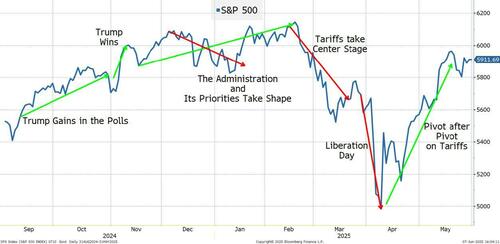
This chart might be a bit simplistic (data centers and AI still play a huge role in the movements of the market, but it isn’t too far off).
- It seems reasonable to expect that after the Big Beautiful Bill is passed (I’m assuming that it will be passed), we will get more clarity on the direction the admin is headed in on tariffs. The President, even working almost 24/7, can only focus on so much, so getting the budget passed is likely taking his attention away from other things (and the bizarre “feud” on Thursday certainly doesn’t help). We should also learn whether the revenue was an artifice to pull in some votes to get approval for the bill (arguing that tariff revenues will offset some costs, until growth kicks in). The “revenue” side of tariffs might be less important after the bill gets passed. On the other hand, maybe the administration doesn’t want to “upset the apple cart” and risk not getting the bill passed? So, after the bill is passed, will we go back to being more aggressive on tariffs?
- With July 8th approaching rather quickly, and only the U.K. deal signed, it seems unlikely that many more fully done deals will be inked before the deadline. On the other hand, the market is pricing in a “worst” case of extensions on the pause. We get some deals announced with a few countries and we get a pause extension on countries where there has been some initial negotiating. That seems reasonable for the markets to assume, given everything that has gone on.
- National Production for National Security. If that has the sound of something that might have been said in a Communist country, I’m okay with it. Prioritizing what is needed and pushing the agenda as aggressively as possible is key for our success and ability to compete with China down the road. Subsidies would help, but they don’t seem to be on the agenda with the urgency many of our National Security experts think is needed. On the other hand, deregulation is also a crucial step and that is something we have argued, since day 1, that Trump has specialized in. Why he didn’t start with deregulation and fighting NIMBY (Not In My Backyard) is a question I would love to have answered (the chart above would look a LOT different if the admin had come out of the gates focused on this front rather than tariffs). Treasury Secretary Bessent talks about this as being one of the “legs of the stool” and the more we turn our attention to this, the better. While it is also designed to take jobs away from elsewhere and bring them to the U.S., it seems less aggressive than using tariffs and is far more in our own control.
- When, or if, will the impact of existing tariffs, policy uncertainty, or even confusion hit the economic data and the markets? We discuss this in our NFP Reaction, and remain convinced that the market, at these levels, has become too complacent with risks on the economic front. While backing off on tariffs has been great, and has greatly reduced the risk of recession, that is still a risk as the global economy takes time to adjust to the level of uncertainty (and even confusion) that has been set in motion since Inauguration Day. I completely believe the worst is behind us on the tariff headlines, but the impact has not been felt in the real world, and while 10% (or just higher) is “manageable,” there are likely going to be costs.
- Peace. While we argued peace in a short timeframe was achievable (peace in a single day seemed impossible), that has stalled, at least in Russia. We published a Drone Attack SITREP on Monday. The mix of carrots and sticks was confusing to many of the GIG members, and maybe it is surprising we are here. The geopolitical situation is different than the economic situation, but if I had to be cautious about something right now – it is the growing difference between how confidently the President predicted peace, and where we are now. It is “different” than tariffs with China, right? Maybe not?
Bottom Line
I still like rates. Friday’s move could have pushed the Fed’s second cut out to next year, while, for me, the jobs data solidified the chance of a July cut, with 3 to 4 for the year. 10s back to 4.5% is a buying opportunity, though a range of 4.2% to 4.6% seems about right. A bit of a wide range, but the volatility around so many of the topics listed above, especially the bill, still needs to be considered.
Credit boring. Crypto exciting.
Credit, which I think I understand, should do okay here. So far the calendar hasn’t slowed much, but credit has held in very well. Across the globe, anyone looking for corporate credit risk needs to come to the U.S. as the market is the only place big enough to offer diversification across industries, ratings, and maturities. Also, the companies issuing corporate debt are often global in nature, so the exposure isn’t confined to the U.S.
On Crypto, I don’t understand the rush for governments to get involved, but it seems that is the trajectory we are on. So long as corporations can add crypto to their balance sheets and see their stock valuations rise more than the amount of crypto they bought, I can understand why they would do that. However, I cannot understand that relationship, which is driving the process. I do understand anxiety around FX globally and deficits globally, but I’m still not sure how that translates into owing crypto – but certainly I am more tempted to jump back on the bandwagon than fight it here.
Equities. Maybe not “priced to perfection” but getting close. When we examine the list of risks, uncertainties, or even things to be confused about, the market seems positioned to the optimistic side. That could be proven correct, but the risk/reward has definitely shifted with the recent legs of this rally (China, chips, and deficit spending). The IPO market is wide open and that could be a big benefit not just to markets, but also for the economy as new and innovative companies are brought to the forefront of daily market headlines!
It has been great being on the road a lot (on the road again this week) and talking to so many of our clients, colleagues, and members of the Geopolitical Intelligence Group.
- There is a decent amount of concern about small and midsize businesses, especially related to tariffs.
- A blind faith that the consumer keeps consuming (which has been the correct call).
- A more optimistic outlook for dealing with China from most people, than generally expressed by our Geopolitical Intelligence Group. We had a great outing with two GIG colleagues from the CIA last week, demonstrating how we are moving deeper into national security and policy.
Today, I just wanted to conclude by thanking all of those who take time out of their hectic schedules to meet with, talk to, or even just respond to Academy Securities as it helps us grow and get better!
If we go back to today’s question “Where are We Now?” the answer is at some pivotal moments for some major drivers to kick into gear, or stumble, as they near the goal line.
- The Big Beautiful Bill. Not letting tax cuts expire is crucial. Additional targeted tax cuts would also be helpful – especially anything that would drive growth and innovation.
-
Site: PeakProsperitySoaring disabilities, gold's steady rise, and China's deflation hint at trouble beneath the surface.
-
Site: Zero HedgeChinese-Owned Firm Halts Construction On Battery Plant In America's EV HeartlandTyler Durden Sun, 06/08/2025 - 12:15
Chinese-owned AESC has halted construction of its $1.6 billion battery plant in America's emerging "Battery Belt," citing economic uncertainty tied to President Trump's trade war and tariffs and the potential early termination of federal clean energy subsidies.
Construction of AESC's electric-vehicle battery plant in Florence, South Carolina, began in 2023 after securing a deal with BMW to make battery cells.
On Thursday, the company sent a letter to employees regarding the construction halt, as obtained by The Wall Street Journal. The letter laid out:
-
Tariffs on Chinese-made machinery, steel, and aluminum, which significantly raise costs.
-
A proposed tax bill in Congress that would end EV battery production subsidies early and restrict eligibility for China-linked companies.
-
Broader industry pressure as automakers slow or cancel EV rollouts.
"Our intent is to finish construction of the facility once stability and predictability have returned to the market," Knudt Flor, AESC's chief executive for the U.S. and Europe, wrote in the memo.
Current and former employees told WSJ that construction of the building has been completed, but all work on installing equipment and battery cell assembly lines has been halted.
Sources noted that AESC would face steep tariffs on EV battery machinery imported from China and said that recent steel and aluminum tariffs imposed by the Trump administration have further compounded the company's cost challenges.
In recent years, Biden-era green energy policies fueled a surge in battery factory construction across parts of the Midwest and Southeast, driven by cheap land, proximity to major automotive hubs, and generous state-level incentives. This region—stretching from Tennessee and Alabama to the Carolinas, Ohio, and Michigan—has become known as America's "Battery Belt."
Some major projects across the belt include:
-
Ford and SK On: $11.4B battery and EV campuses in Tennessee and Kentucky
-
LG Energy Solution: Multiple joint ventures with GM, Stellantis, and Honda in Michigan, Ohio, and Indiana
-
Hyundai and SK: $5B EV battery plant in Georgia
-
Toyota: Expanding EV battery production in North Carolina
"Now many of those subsidies are being targeted by Republicans at the same time regulations and tax credits aimed at driving EV sales are also at risk," WSJ noted, adding, "The current version of a tax bill before Congress would end EV battery production subsidies a year early and make them unavailable to companies with ties to certain countries, including China."
-
-
Site: Zero HedgeBillions Spent On Data Centers - But Where Is The AI Adoption Rate?Tyler Durden Sun, 06/08/2025 - 12:15
This week, readers were given fresh insights from UBS (read: here & here), highlighting the explosive surge in data center investments. As we've noted before, one asset manager—backing a multi-billion-dollar AI data center project in Texas—described to us the current AI infrastructure buildout as a multi-year "sprint."
With hundreds of billions pouring into data center development—concentrated in Texas and the Heartland due to cheap land and reliable power—investors should be asking one critical question: how fast is AI adoption scaling across corporate America?
According to Goldman Sachs' latest AI Adoption Tracker for Q2 2025, the enterprise implementation of AI continues to expand, particularly across sectors most vulnerable to automation. At the same time, productivity gains are becoming more measurable, even as AI-related layoffs have yet to materialize.
Analysts Jan Hatzius, Joseph Briggs, and others offered clients a clear snapshot of the current AI investment tsunami:
AI-related investment growth remains strong, particularly for semiconductor firms, where equity analysts expect revenue growth of 36% from current levels by the end of 2026. Since the release of ChatGPT, analysts have upgraded their end-2025 revenue projections for semiconductors by $200bn (0.7% of US GDP) and AI hardware enablers by $105bn (0.4%).
As for the AI adoption rate, analysts found that as of May, approximately 9.2% of U.S. firms reported using AI in the production of goods or services—up from 7.4% in 4Q24.
The most significant quarter-over-quarter gains occurred in the education, information, finance, and professional services sectors.
"Large firms with 250+ employees continue to report the highest adoption rate (14.9%) while medium-sized firms with 100-249 employees reported the largest expected increase in adoption over the next 6 months (+4.7pp to 14.6%). Adoption rates have also accelerated among medium-sized firms with 150-249 employees," the analysts said.
Certain subsectors—especially in computing, web hosting, and telecom—are seeing adoption rates exceed 30%. Broadcasting and telecommunications firms anticipate the largest adoption gains through the rest of 2025.
Given the increasing AI adoption rate, the analysts noted that AI's impact on employment metrics has been marginal:
AI's impact on the labor market remains limited and there is no sign of a significant impact on most labor market outcomes. AI-related job openings now account for 24% of all IT job openings and 1.5% of all job postings. AI has not been mentioned in major corporate layoff announcements in recent months and the unemployment rate for AI-exposed positions has reconciled with the broader unemployment rate.
However...
We continue to observe large impacts on labor productivity in the limited areas where generative AI has been deployed. Academic studies imply a 23% average uplift to productivity, while company anecdotes imply similar efficiency gains of around 29%.
Here's what companies and trade organizations are saying about current and future AI adoption...
Ultimately, investors will need to see AI adoption across corporate America continue to climb in order to justify the massive infrastructure buildout.
The looming question now is: At what point does rising adoption trigger a wave of AI-driven layoffs?
-
Site: Fr. Z's BlogGetting ready for confirmations at The Parish™. Photos from The World’s Best Sacristan™. Please remember me when shopping online and use my affiliate links. US HERE – WHY? This helps to pay for health insurance, utilities, groceries, etc.. At no extra cost, … Read More →
-
Site: Zero HedgeFederal Appeals Court Upholds Limits On Florida Drag Show, Including No Minors RuleTyler Durden Sun, 06/08/2025 - 11:40
Authored by Tom Ozimek via The Epoch Times,
A federal appeals court has ruled that the city of Naples, Florida, can lawfully require a drag performance at this weekend’s Pride Fest event to be held indoors and restricted to adult audiences.
In a split June 6 decision, the U.S. Court of Appeals for the 11th Circuit reversed a lower court’s preliminary injunction blocking local restrictions. The court found that Naples Pride, the nonprofit organizing the event, had waited too long to challenge the conditions after accepting the same terms in 2023 and 2024.
The majority concluded that the city’s decision to impose the restrictions was not based on the group’s viewpoint, but rather on public safety concerns. The judges also held that the performance venue—a city park—constitutes a “limited public forum,” where speech protections under the First Amendment are subject to greater regulation.
The court added that the performance could still go forward under the same conditions as in previous years—indoors and adults-only—and that the city had a strong argument that its rules were reasonable and viewpoint-neutral.
In dissent, Circuit Judge Nancy Abudu criticized the majority’s reasoning, arguing that the city’s restrictions were “undeniably viewpoint and content-based” and thus unconstitutional, regardless of whether the park is viewed as a traditional or limited public forum.
Earlier this month, U.S. District Judge John Steele issued a preliminary injunction barring Naples from enforcing the indoor and age-restriction requirements. That ruling came in response to a lawsuit filed in April by the ACLU of Florida on behalf of Naples Pride, alleging violations of constitutional free speech rights.
Reacting to the 11th Circuit’s reversal, the ACLU of Florida called the decision “disappointing” and vowed to continue the legal fight. Naples Pride likewise criticized the ruling, but said it would comply with the restrictions, for now.
“We respect the rule of law and will comply with the restrictions—but we won’t pretend this is justice,” Callhan Soldavini, board member and corporate counsel for Naples Pride, said in a statement. “Righting the wrongs of injustice takes time, but make no mistake: we will keep fighting.”
The case now returns to the lower court, where Naples Pride’s claims for damages will proceed.
In response to the ruling, the Naples Police Department said on June 6 that the police would be on-site during the event to ensure public safety.
“As a result, the City may continue enforcing its event ordinance while the case proceeds,” the department said in a post on social media. “We remain committed to protecting public safety, upholding constitutional rights, and ensuring the safe use of public spaces.”
Meanwhile, the same court of appeals ruled in mid-May that a Florida restaurant known for hosting drag shows could continue hosting the performances pending further litigation in a case that challenges enforcement of the state’s Protection of Children Act.
The law prohibits the admission of children into live performances that Florida considers obscene for minors. However, the court found that the restrictions in the act were too vague as they applied to the shows held at the restaurant.
-
Site: Zero HedgeMusk Hit Bessent 'Like A Rugby Player' In White House Fight, Bannon ClaimsTyler Durden Sun, 06/08/2025 - 11:05
Long-simmering tensions between Elon Musk and other members of the Trump administration exploded into physical violence in mid-April, with Musk aggressively shouldering Treasury Secretary Scott Bessent and Bessent battling back, according to a second-hand account from Trump political advisor and Musk-despiser Steve Bannon. First reported by the Washington Post on Saturday, Bannon's tale comes amid a raging battle between Trump and Musk that's left Trump saying he has no desire to patch things up and assumes their relationship -- which by all accounts played a decisive role in Trump's return to power -- is over.
 The alleged fight between Musk and Bessent erupted after an Oval Office discussion over who should be the IRS acting commissioner (Reuters)
The alleged fight between Musk and Bessent erupted after an Oval Office discussion over who should be the IRS acting commissioner (Reuters)
Citing what he'd been told by others, Bannon said the two rivals had been with Trump in the Oval Office to pitching their respective preferred picks for the role of acting IRS commissioner. According to earlier reporting by the New York Times, Bessent was irate that Musk had managed to go around him and install Gary Shapley in the role, despite the fact that the IRS reports to the Treasury Department. Bessent told Trump he wanted Deputy Treasury Secretary Michael Faulkender in the slot -- and Trump agreed, capping a chaotic spectacle that saw the IRS overseen by three different acting commissioners in a single week.
As they left the office and headed down a West Wing hallway, Bessent and Musk started insulting each other, Bannon said, with Bessent ridiculing Musk for claiming he would identify over a trillion dollars in government waste, fraud and abuse, with Bessent apparently claiming Musk was coming nowhere close: "You’re a fraud. You’re a total fraud!"
That line of attack allegedly prompted Musk to slam his shoulder into Bessent's ribs, hitting him hard "like a rugby player," said Bannon. The Treasury secretary physically retaliated in some manner, before multiple bystanders outside the national security adviser's office intervened to break up the fight. Musk was then supposedly escorted from the West Wing. “President Trump heard about it and said, ‘This is too much’,” Bannon said. In the following days, Musk announced that he would start easing back from his role in the administration to give more attention to his many businesses.
I've received reliable reports that Scott Bessent fought Musk from a classical Wall Street office boxing stance similar to below pic.twitter.com/eZ58tIOqFf
— Second City Bureaucrat (@CityBureaucrat) June 5, 2025Bannon's gossipy, second-hand account in the Washington Post's decidedly Musk-hostile report came two days after the told the New York Times that he was pushing to have Musk deported. “They should initiate a formal investigation of his immigration status, because I am of the strong belief that he is an illegal alien, and he should be deported from the country immediately,” Bannon said, adding that he also told Trump to pursue a narcotics investigation against Musk.
According to the Post, the Musk-Bessent fight was just one of many manifestations of friction between the world's richest man and others in the administration who resented his "move fast and break things" approach and the influence he wielded not as a Senate-confirmed cabinet member but as a mere "special government employee." Musk was seen as failing to stay in his ill-defined lane, with no better example than his bypassing of cabinet members by issuing direct, emailed commands to nearly every employee in the federal government:
The first signs of trouble emerged in February, when an email landed in inboxes throughout the government directing federal employees to describe their five accomplishments over the past week. Cabinet officials and other agency leaders weren’t given advance notice of the memo, causing consternation at the highest levels of Trump’s administration.
This week's massive meltdown in the Trump-Musk relationship started when Musk lashed out against the "Big Beautiful Bill," calling Trump's cornerstone legislation a "disgusting abomination" and heaping scorn on House members who voted for it (Kentucky's Thomas Massie and Ohio's Warren Davidson were the sole GOP "no" votes).
I’m sorry, but I just can’t stand it anymore.
— Elon Musk (@elonmusk) June 3, 2025
This massive, outrageous, pork-filled Congressional spending bill is a disgusting abomination.
Shame on those who voted for it: you know you did wrong. You know it.Things quickly went downhill, with Trump threatening to kill Musk's SpaceX and Starlink contracts, only to have Musk announce he was immediately decommissioning SpaceX's Dragon spacecraft, which NASA relies on to transport supplies and crew members to the International Space Station (he later eased back on that threat.) Musk also backed a suggestion that Trump be impeached, and said "the real reason [the Epstein files] have not been made public" is that Trump is in them.
For now, the outright hostilities have eased, but there's little reason to think the Trump-Musk relationship will be meaningfully restored. As an unnamed administration ally close to the Trump and Musk camps told the Post, "There’s hope that there’s going to be a reconciliation. But it’ll never be the same.”
-
Site: Fr. Z's BlogToo many people today are without good, strong preaching, to the detriment of all. Share the good stuff. Was there a GOOD point made in the sermon you heard at your Mass of obligation for the Pentecost Sunday? Tell about … Read More →
-
Site: Fr. Z's BlogThe Fiftieth Day Feast, Hebrew Shavuot or Greek Pentekosté, for the Jews commemorated the descent of God’s Law to Moses on Mount Sinai, wreathed in fire, fifty days after the Exodus. But Jewish feasts also looked forward even as they … Read More →
-
Site: Catholic ConclaveGrand Pardon of Sainte-Anne-d’Auray. “Isn’t there a more legitimate Cardinal than Robert Sarah?”No!Readers’ letters. “Cardinal Robert Sarah will represent Pope Leo XIV in Sainte-Anne-d’Auray (Morbihan) on the 400th anniversary of an original event. Pope Francis must be turning in his grave!”“How can Sarah, the “traditional,” represent this new pope, who is in line with Pope Francis’s Catholic Conclavehttp://www.blogger.com/profile/06227218883606585321noreply@blogger.com0
-
Site: Zero HedgeFTC Warns Of Rising Student Loan Scams, Says Fraudsters Took Millions From BorrowersTyler Durden Sun, 06/08/2025 - 10:30
Authored by Chase Smith via The Epoch Times (emphasis ours),
The Federal Trade Commission (FTC) is warning borrowers to steer clear of student loan debt-relief scams, after shutting down a group of companies last month that allegedly charged millions in illegal fees and left customers worse off.
 Graduates attend a commencement ceremony at Harvard University in Cambridge, Mass., on May 29, 2025. Rick Friedman/AFP via Getty Images
Graduates attend a commencement ceremony at Harvard University in Cambridge, Mass., on May 29, 2025. Rick Friedman/AFP via Getty Images
The warning, issued June 6, comes as part of a broader push by the FTC to raise awareness about deceptive debt-relief schemes targeting Americans with student loans.
In a recent enforcement action, the agency permanently banned California-based Panda Benefit Services and its affiliates from the debt-relief industry. The FTC said the companies posed as partners of the Department of Education and promised borrowers quick loan forgiveness in exchange for upfront payments.
According to the FTC, the companies collected more than $16.7 million from consumers who were told their loans would be forgiven or significantly reduced. Instead, the scammers kept the money and never delivered on their promises.
“It’s illegal for anyone to charge fees before they help you or to pretend they’re affiliated with the Department of Education,” the FTC said in the consumer alert.
The Education Department does not work with private companies that demand payment in advance, and borrowers should be cautious of anyone claiming otherwise.
The now-banned companies, including those doing business under names like Prosperity Benefit Services and Pacific Quest Services, were first sued in 2024. At the time, the FTC alleged the operators sent deceptive mailers marked “FINAL NOTICE” and “Time Sensitive,” and made false promises of full loan forgiveness.
Borrowers were also misled into sharing personal financial details, including their Federal Student Aid ID, which scammers could use to access accounts or steal identities.
The case was one of the FTC’s first under a new federal rule that strengthens its ability to penalize those impersonating government agencies. Several judgments in the case ordered the defendants to surrender assets and banned them from telemarketing and making misrepresentations about financial services.
The FTC emphasized that no private company can do anything for borrowers that they can’t do themselves for free at StudentAid.gov. This includes applying for income-driven repayment plans, consolidating loans, or exploring forgiveness options—none of which require payment to third-party services.
Federal law also prohibits companies from pretending to be affiliated with the Department of Education. But scammers frequently misuse official-sounding names and seals to appear legitimate.
Borrowers struggling to repay federal loans can explore free options, including deferment, forbearance, and income-driven repayment plans. In some cases, they may also qualify for forgiveness based on long-term payment history or employment in public service.
The agency is urging the public to report suspected scams at ReportFraud.ftc.gov, contact their state attorney general, and find out more at ftc.gov/StudentLoans.
-
Site: Steyn OnlineIn case you missed it, here's how the last seven days looked at SteynOnline...
-
Site: Steyn OnlineProgramming note: Mark will be back in audio on Friday with the latest entry to our series of audio adventures, Tales for Our Time. ~If you missed today's Serenade Radio broadcast of our audio Song of the Week, here's a chance to catch up. In this show
-
Site: Zero HedgeWill Beijing De-Dollarize Or Dump US Treasury Debt?Tyler Durden Sun, 06/08/2025 - 09:20
Authored by Milton Ezrati via The Epoch Times,
Anticipating what tactics Beijing might use against U.S. President Donald Trump amid trade negotiations, several media outlets here, in Europe, and elsewhere have begun to speculate that China will threaten to distance its economy and its trade from the dollar—de-dollarize in the popular parlance—and perhaps sell off its extensive holdings of U.S. Treasury debt.
Neither act, however, is at all likely, certainly not as an immediate bargaining chip.
It is easy to see why commentators would seize on notions like de-dollarization. Beijing for years has sought to raise the yuan’s international profile, often at the expense of the U.S. dollar. In its wide-ranging Belt and Road Initiative, for instance, it often insists that arrangements and contracts are denominated in yuan and not dollars, as is customary elsewhere.
Beijing has promoted the idea of moving away from the dollar among the so-called BRICS nations (Brazil, Russia, India, China, and South Africa). China’s Asian Infrastructure Investment Bank denominates loans and grants in yuan, not dollars. Beijing has contracted for large oil purchases in yuan, not dollars. Its extensive dealings with Russia dispense with the use of dollars. And the People’s Bank of China has aided the effort by promoting a digital yuan.
But Beijing is also well aware that China, as an export-dependent economy, must hold dollars to back its trading activities with most nations.
For all Beijing’s efforts to supplant the dollar with the yuan, the dollar nonetheless acts as a basis for 80 percent of the world’s import-export activity, even when Americans are not involved. The dollar has a presence in 90 percent of all currency transactions, compared with only 4 percent for the yuan.
China could shed the dollar and still have access to global trading and currency arrangements, but it would have to accept much less effective and efficient arrangements to do so.
In other words, de-dollarization would hurt China much more than it would hurt the United States, and both Beijing and Washington know this.
Nor is China likely to threaten the sale of its holdings of U.S. Treasury debt.
There is no denying that China’s holdings are huge. Some estimates put the figure at just under $1 trillion, second only to Japan’s holdings of about $1.13 trillion. This would seem to give Beijing leverage, but all involved know that the sale of these holdings would deny China a liquid market in which to invest its necessary holdings of U.S. dollars.
Moreover, an extensive sale would depress the price of U.S. Treasury bonds, imposing losses on Beijing’s balance sheet at a time when China’s domestic economic troubles make such a loss especially hard to bear. To be sure, such a sell-off would hurt Washington, but it would hurt Beijing even more, and both sides know it.
Beijing also knows that China’s interests would suffer from the tendency for any of these steps to weaken the dollar’s foreign exchange value and strengthen the yuan. In these circumstances, China’s central authorities would do better to weaken the yuan’s foreign exchange value, especially against the dollar. Such an action would make Chinese goods cheaper to dollar-based buyers and accordingly offset some of the adverse pricing impact of existing and threatened U.S. tariffs.
Instead, the yuan has recently gained value against the dollar. Beijing could reverse this trend if it were to talk down the currency actively by publicly eschewing de-dollarization and any talk of selling off holdings of U.S. Treasury debt.
It hardly warrants saying that matters today remain highly uncertain.
Trump’s next move is impossible to guess, as is Beijing’s.
For all the uncertainty, however, it is still possible to set aside all the talk of de-dollarization and asset sell-offs, for the very practical reasons outlined here and also because Beijing, in these ongoing negotiations, has zero interest in antagonizing Washington.
Views expressed in this article are opinions of the author and do not necessarily reflect the views of The Epoch Times or ZeroHedge.
-
Site: AsiaNews.itAt Pentecost Mass, exhortation to welcome the Holy Spirit who breaks down walls and prejudices between peoples: 'Where there is love there is no room for the exclusion that emerges from political nationalisms.At last night's vigil, message to movements and associations gathered for their Jubilee: "Evangelization is not a human conquest of the world".



